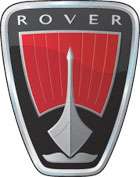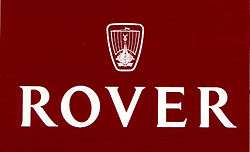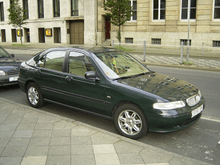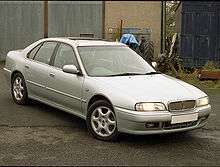Rover (marque)
 | |
| Owner | Tata Motors |
|---|---|
| Country | United Kingdom |
| Introduced | 1878 |
| Discontinued | 2005 |
| Markets | Automotive |
| Previous owners |
Rover Company (1878-1967) British Leyland (1967-1986) Rover Group (1986-1988) British Aerospace (1988-1994) BMW (1994-2006; licensed to MG Rover, 2000-2005) Ford (2006-2008) Tata Motors (2008-) |
Rover is a British automotive marque used between 1904 and 2005. It was launched as a bicycle maker called Rover Company in 1878, before manufacturing cars in 1904. The brand used the iconic Viking longship as its logo.
Despite a state-controlled absorption by the Leyland Motor Corporation (LMC) in 1967 and subsequent mergers, nationalisation, and de-mergers, the Rover marque retained its identity first as an independent subsidiary division of LMC, then through variously named groups of British Leyland through the 1970s and into the 1980s.
The Rover marque became the primary brand of the then newly renamed Rover Group in 1988 as it passed first through the hands of British Aerospace and into the ownership of BMW Group. Sharing technology with Honda and financial investment during the BMW ownership led to a revival of the marque during the 1990s in its core midsize segment.[1]
In 2000, BMW sold the Rover and related MG car activities of the Rover Group to the Phoenix Consortium, who established the MG Rover Group at Longbridge. BMW retained ownership of the Rover marque, allowing MG Rover to use it under licence. In April 2005, Rover branded cars ceased to be produced when the MG Rover Group became insolvent.
BMW sold the Rover marque to Ford in 2006 for approximately £6 million, the latter exercising an option of first refusal to buy it dating back to its purchase of Land Rover. Ford thus reunited the original Rover Company marques, primarily for brand-protection reasons.[2]
In March 2008, Ford reached agreement with Tata Motors of India to include the Rover marque as part of the sale of their Jaguar Land Rover operations to them, alongside related Daimler and Lanchester marques. Legally the Rover marque is the property of Land Rover under the terms of Ford's purchase of the name in 2006.[3]
In the middle of the decade, SAIC Motor Corporation Limited attempted to acquire MG Rover, but in 2005 was outbid by another Chinese automaker, Nanjing Automobile. SAIC did manage to obtain some MG Rover technology that was incorporated into a new line of luxury sedans under the Roewe marque.
With no Rover vehicles currently in production, the marque is considered dormant.
British Leyland
In 1970, Rover combined its skill in producing comfortable saloons and the rugged Land Rover 4x4 to produce the Range Rover, one of the first vehicles (preceded by the Jeep Wagoneer and IH Scout) to combine off-road ability and comfortable versatility. Powered by the licence-built ex-Buick V8 engine, it had innovative features such as a permanent four-wheel drive system, all-coil spring suspension, and disc brakes on all wheels. Able to reach speeds of up to 100 mph (160 km/h) yet also capable of extreme off-road use, the original Range Rover design remained in production for the next 26 years.
The company's other major project at this time was the P8, a successor, styled by David Bache, for the 3-litre.[4] The car's shape owed much to Detroit, with a front bumper concealed under a "bumperless" polyurethane nose, in a manner reminiscent of contemporary Pontiacs, and a side profile reminiscent of a slightly chunkier Opel Rekord.[4] Although the original brief was for the car to be no longer externally than a Rover 2000, management changes led the project to be redefined as it progressed, and the P8 scheduled for launch at the 1971 London Motor Show was substantially larger than any existing Rover sedan, with the Rover V8 engine expanded for this application to 4.4 litres.[4] The car followed the P6 in employing a steel frame structure with bolt-on steel or aluminium panels. The manufacturer was nevertheless short of cash and focus at this time: the P8 was one of several new model projects subjected to a slipping time-line.[4] By the revised launch date towards the end of 1972 the considerable development costs had been expended and pre-production prototypes had even undergone extensive testing in Finland. Production capacity had been set aside for the P8 at the Solihull plant.[4] However, an expenditure review in 1970 found the project subjected to criticism from Sir William Lyons, by now an influential member of the British Leyland board: speculation has arisen that Lyons saw the car as a threat to future investment in the recently launched Jaguar XJ6.[4] It later emerged that Rover's contender would not have been particularly cheap or easy to build, and the shrinkage of the European market for sedans of this size that followed the 1973 oil price shock suggest that abandonment of the project in 1972 - even at the eleventh hour - may have been the right decision for British Leyland; but the P8 was not entirely ummourned nearly thirty years later.[4] Some of the P8's styling cues turned up two years later on the Leyland P76, and the driver's view of the instrument panel (albeit without the Austin Allegro style "quartic" steering wheel that appears in one of the surviving pictures of it) would have been not entirely unfamiliar to the driver of a 1976 Rover 3500.[4]
As British Leyland struggled through financial turmoil and an industrial-relations crisis during the 1970s, it was effectively nationalized after a multibillion-pound government cash injection in 1975. Michael Edwardes was brought in to head the company.

The Rover SD1 of 1976 was an excellent car, but was beset with so many build quality and reliability issues it never delivered on its great promise. Following the closure of the Triumph factory at Canley, production of the TR7 and TR8 was moved to Solihull; soon after, a savage programme of cutbacks in the late 1970s led to the end of car production at Solihull, which was turned over for Land Rover production only. The TR7/TR8 was discontinued while SD1 production moved to Cowley. All future Rover cars would be made in the former Austin and Morris plants in Longbridge and Cowley, respectively.
In 1979, British Leyland (or as it was now officially known, BL Ltd.) began a long relationship with the Honda Motor Company of Japan. The result was a cross-holding structure, where Honda took a 20% stake in the company while the company took a 20% stake in Honda's UK subsidiary. The deal was thought to be mutually beneficial: Honda used its British operations as a launchpad into Europe, and the company could pool resources with Honda in developing new cars.
Austin Rover Group was formed in 1982 as the mass-market car manufacturing subsidiary of BL, with the separate Rover Company becoming effectively defunct.
In the 1980s, the slimmed-down BL used the Rover brand on a range of cars codeveloped with Honda. The first Honda-sourced Rover model, released in 1984, was the Rover 200, which, like the Triumph Acclaim that it replaced, was based on the Honda Ballade. Similarly, in Australia, the Honda Quint (known in Europe as the Quintet) and Integra were badged as the Rover Quintet and 416i.
Rover Group


By 1988, Austin Rover had moved to a one-marque strategy, using only the Rover brand. Its parent, BL, was renamed as the Rover Group, with the car division becoming Rover Cars.
In 1986, the Rover SD1 was replaced by the Rover 800, developed with the Honda Legend. The Austin range were now technically Rovers, though the word "Rover" never actually appeared on the badging. Instead, there was a badge similar to the Rover Viking shape, without wording. The Metro was officially badged as a Rover when the restyled version was launched in May 1990. The second generation Rover 200, based on Honda's Concerto, was launched in the autumn of 1989, but now featured a hatchback instead of a four-door saloon, the bodystyle which would feature on the Rover 400 (visually similar and based on the same underpinnings) from its launch in early 1990. The larger Rover 600, launched in early 1993, was based on the Accord but used Rover engines only and was aimed further upmarket at the likes of the BMW 3 Series rather than the likes of the Ford Mondeo which the Honda Accord was marketed to compete with.
Rover exported Rover 800s, badged as Sterlings, to the United States from 1987 to 1992.
British Aerospace ownership
In 1988, the Rover brand went back into private hands when the Rover Group was acquired by British Aerospace.
BMW ownership
The Honda partnership proved to be the turnaround point for the company, steadily rebuilding its image to the point where once again, Rover-branded cars were seen as upmarket alternatives to Fords and Vauxhalls. In 1994, British Aerospace sold the Rover Group, including the Rover, Land Rover, Riley, Mini, Triumph, and Austin-Healey brands to BMW, who had begun to see Rover-branded cars as potential major competitors.
Under BMW, the Rover Group developed the Rover 75 and was launched in early 1999, as a retro-designed car influenced by the earlier Rover P4 and P5 designs. It proved to be a success for the marque, gaining positive critics, although it failed to outsell the BMW 3 Series.
In May 2000, BMW split up the Rover Group, selling Land Rover to the Ford Motor Company for an estimated sum of £1.8-billion, retaining the MINI marque, and selling the rest of the car business to the Phoenix Consortium, who established it as MG Rover. Interestingly, although BMW included ownership of the MG brand in the deal, they retained ownership of the Rover brand, licensing its use to the new MG Rover company for use on the ongoing car models that they had acquired.
MG Rover licensing


A specially assembled group of businessmen, known as the Phoenix Consortium and headed by ex-Rover chief executive John Towers, established the MG Rover Group from the former Rover Group car operations (acquired from BMW for a nominal £10 in May 2000) and continued to use the Rover brand under licence from BMW.
In 1999, the Rover Group had sustained losses of an estimated £800 million - largely due to the declining sales of its existing 200 and 400 family cars and initially slow sales of the Rover 75. The four businessmen who took control of the newly formed MG Rover Group are reported to have received around £430-million in a dowry from BMW that included unsold stock.
The first new Rover-branded car to be launched after the formation of MG Rover was the estate version of the Rover 75, which went on sale later in 2000. In 2003, MG Rover launched the CityRover, a badge-engineered Tata Indica that served as an entry-level model. Despite high initial expectations, sales were poor, and it received mainly negative critics. Several concept cars intended to point the way towards a replacement for the Rover 25 and 45 were shown in the early 2000s, but no production model emerged.
MG Rover production ceased on 15 April 2005, when it was declared insolvent, resulting in the immediate loss of more than 6,000 jobs at the company. On 22 July 2005, the physical assets of the collapsed firm were sold to the Nanjing Automobile Group for £53m. They indicated that their preliminary plans involved relocating the Powertrain engine plant to China while splitting car production into Rover lines in China and resumed MG lines in the West Midlands (though not necessarily at Longbridge), where a UK R&D and technical facility would also be developed.
On 30 May 2007, Nanjing Automobile Group claimed to have restarted production of MG TF sports cars in the Longbridge plant, with sales expected to begin in the autumn.
Shanghai Automotive Industry Corporation (SAIC), who held the intellectual property of Rover 75 car design (bought for £67m before MG Rover collapsed) and was also bidding for MG Rover, announced their own version of the Rover 75 in late 2006. In July 2006, SAIC announced their intent to buy the Rover brand name from BMW, who still owned the rights to the Rover marque.[5] However, BMW refused their request, due to an agreement that Ford had reached with them to be given first option on the brand when it acquired Land Rover. Unable to use the Rover name, SAIC created their own brand with a similar name and badge, known as Roewe. Roewe was eventually launched in early 2007.
Ford Motor Company ownership of the brand name
Ford had first option to purchase the Rover brand name if MG Rover ceased trading, a right that had been negotiated when the Land Rover brand was bought from BMW. This right was exercised on 18 September 2006,[6] and effectively meant the return home of the Rover brand to Solihull since the SD1 was moved to the Morris plant in Cowley in 1981. No Rover-branded cars were produced whilst Ford owned the brand, and in a further twist, Tata Motors now owns the brand that was used for the ill-fated CityRover model, a rebadged Tata Indica marketed by MG Rover under licence in the UK Market from 2003 to 2005. Tata had purchased the Land Rover and Jaguar operations from Ford in 2008 to form Jaguar Land Rover.
Tata Motors' ownership of the brand name
As part of Ford's agreement to sell their Jaguar and Land Rover operations to Tata Motors, the Rover brand name was included in the deal, but has yet to be revived on any production cars.[7]
Models
Launched under the independent Rover Company pre-merger (1904–1967)

- 1904–1912 Rover 8
- 1906–1910 Rover 6
- 1906–1910 Rover 16/20
- 1912–1923 Rover 12
- 1919–1925 Rover 8
- 1924–1927 Rover 9/20
- 1925–1927 Rover 14/45
- 1927–1932 Rover Light Six
- 1927–1947 Rover 10
- 1929–1932 Rover 2-Litre
- 1930–1934 Rover Meteor 16HP/20HP
- 1931–1940 Rover Speed 20
- 1932–1933 Rover Pilot/Speed Pilot
- 1932–1932 Rover Scarab
- 1934–1947 Rover 12
- 1934–1947 Rover 14/Speed 14
- 1937–1947 Rover 16
- 1948–1978 Land Rover (I/II/III)—In 1978, BL established Land Rover Limited as a separate subsidiary; it took over Land Rover production.
- 1948–1949 Rover P3 (60/75)
- 1949–1964 Rover P4 (60/75/80/90/95/100/105/110)
- 1958–1973 Rover P5 (3-Litre/3.5-Litre)
- 1963–1977 Rover P6 (2000/2200/3500)
Launched under the Rover Company as a BLMC/BL subsidiary (1967–1986)
.jpg)
- 1970–1978 Range Rover—In 1978, BL established Land Rover Limited as a separate subsidiary; it took over Range Rover production.
- 1976–1986 Rover SD1 (2000/2300/2400/2600/3500/Vitesse)
- 1983–1985 Rover Quintet-Australian market
- 1984–1999 Rover 200 (211/213/214/216/218/220)
- 1985–1989 Rover 416i—Australian market
Other BL cars rebranded as a Rover (1986–2000)

- Mini/Supermini cars
- 1986–2000 Rover Mini — Originally called the Austin Seven/Morris Mini Minor in 1959, but renamed Rover Mini in 1986.
- 1990–1998 Rover Metro, Rover 100 (111/114/115) — Originally called the Austin Metro. Rebranded as a Rover three years after Austin's fall.
- Family cars
Rover-branded models launched under the Rover Group (1986–2000)


- Family cars
- 1992–1998 Rover 200 Coupe (216/218/220/220 Turbo)
- 1990–2000 Rover 400 (414/416/418/420)
- 1993–1999 Rover 600 (618/620/623 and 620ti)
- Executive cars
- 1986–1998 Rover 800 (820/825/827 and Vitesse) and Sterling
- 1998–2005 Rover 75
Rover & MG-branded models launched under MG Rover (2000–2005)

- Mini/Supermini cars
- 2003–2005 CityRover
- 2005 CityRover MK II
- Family cars
- 2000–2004 Rover 25
- 2000–2004 Rover 45
- 2000–2004 Rover 75
- 2000–2004 Rover 75 TOURER
- 2003–2004 Rover Streetwise
- 2004–2005 Rover 25 MK II
- 2004–2005 Rover 45 MK II
- 2004–2005 Rover 75
- 2004–2005 Rover 75 TOURER
- 2004–2005 Rover Streetwise MK II
- Van
- 2003–2005 Rover Commerce[8]

- Family cars
ROVER based rebranded vehicles
- Sportscar
- 2000–2002 MG-F
- 2002–2005 MG-TF
Van
- 2003–2005 MG ZR[9]
See also
- Austin Rover Group
- Rover Group
- MG Rover Group
- Nanjing Automobile Group
- List of car manufacturers of the United Kingdom
- MGBD PARTS & SERVICES
References
- ↑ Chris Brady & Andrew Lorenz (2005). End of the Road: The Real Story of the Downfall of Rover. Prentice Hall. ISBN 0-273-70653-5.
- ↑ Doran, James (19 September 2006). "Ford pays £6m for Rover marque". The Times. Retrieved 2006-09-19.
- ↑ Kirill Ougarov (28 March 2008). "Tata gets trio of Brit marque names as part of JLR buy". Motor Trend. Source Interlink Media. Retrieved 2008-04-08.
- 1 2 3 4 5 6 7 8 "Mortally wounded ... by Jaguar: Rover would probably be in a much healthier state today if it had not received a massive blow from Jaguar 30 years ago...". CAR: 100. December 2000.
- ↑ "BMW agrees to sell Rover brand to SAIC". Reuters. Retrieved 2006-08-16.
- ↑ "Ford buys Rover brand name from BMW".
- ↑ "5 for 2 special: Tata acquires 3 other British marques in Jaguar, Land Rover deal". Leftlane News. 28 March 2008. Retrieved 2008-03-28.
- ↑ "Austin Rover Online". Austin-rover.co.uk. Retrieved 2010-10-15.
- ↑ "The Motoring World Blog". jomomag.blogspot.com/. Retrieved 2016-09-17.
External links
![]() Media related to Rover vehicles at Wikimedia Commons
Media related to Rover vehicles at Wikimedia Commons
| British Leyland – car companies and marques | |||||||||||||||||||||||||||||||||||||||||||||||||||||||||||||
|---|---|---|---|---|---|---|---|---|---|---|---|---|---|---|---|---|---|---|---|---|---|---|---|---|---|---|---|---|---|---|---|---|---|---|---|---|---|---|---|---|---|---|---|---|---|---|---|---|---|---|---|---|---|---|---|---|---|---|---|---|---|
| Marque | 1900s | 1910s | 1920s | 1930s | 1940s | 1950s | 1960s | 1970s | 1980s | 1990s | 2000s | 2010s | |||||||||||||||||||||||||||||||||||||||||||||||||
| Jaguar | SS Cars | Jaguar | Jaguar & Daimler |
BMH | BLMC / British Leyland | Jaguar & Daimler |
Ford (PAG) | Tata | |||||||||||||||||||||||||||||||||||||||||||||||||||||
| Daimler | Daimler | BSA | BSA | ||||||||||||||||||||||||||||||||||||||||||||||||||||||||||
| Lanchester | Lanchester | ||||||||||||||||||||||||||||||||||||||||||||||||||||||||||||
| Rover | Rover Company | Rover Company | Rover Company | Austin Rover Group & Land Rover Group (BL plc) |
Rover Group (BAe) | Rover Group (BMW) |
MG Rover Group (PVH) | ||||||||||||||||||||||||||||||||||||||||||||||||||||||
| Land Rover | Ford (PAG) | ||||||||||||||||||||||||||||||||||||||||||||||||||||||||||||
| Alvis | Alvis | BAE Systems | |||||||||||||||||||||||||||||||||||||||||||||||||||||||||||
| Standard | Standard | Standard Triumph | Leyland Motors | British Motor Heritage | |||||||||||||||||||||||||||||||||||||||||||||||||||||||||
| Triumph | Dawson | Triumph | BMW | ||||||||||||||||||||||||||||||||||||||||||||||||||||||||||
| Riley | Riley | Nuffield Organisation | BMC | BMH | |||||||||||||||||||||||||||||||||||||||||||||||||||||||||
| MG | Morris Garages (MG) | Rover Group (BMW) |
MG Rover Group (PVH) | SAIC & NAC |
SAIC | ||||||||||||||||||||||||||||||||||||||||||||||||||||||||
| Morris | Morris | Morris | |||||||||||||||||||||||||||||||||||||||||||||||||||||||||||
| Wolseley | Wolseley | ||||||||||||||||||||||||||||||||||||||||||||||||||||||||||||
| Austin | Austin | Austin | |||||||||||||||||||||||||||||||||||||||||||||||||||||||||||
| Vanden Plas | Vanden Plas | ||||||||||||||||||||||||||||||||||||||||||||||||||||||||||||
| Mini | BMW | ||||||||||||||||||||||||||||||||||||||||||||||||||||||||||||
| Princess | BMC | BLMC / British Leyland | |||||||||||||||||||||||||||||||||||||||||||||||||||||||||||
| Austin-Healey | Austin (BMC) & Donald Healey | ||||||||||||||||||||||||||||||||||||||||||||||||||||||||||||
| Marque | 1900s | 1910s | 1920s | 1930s | 1940s | 1950s | 1960s | 1970s | 1980s | 1990s | 2000s | 2010s | |||||||||||||||||||||||||||||||||||||||||||||||||
